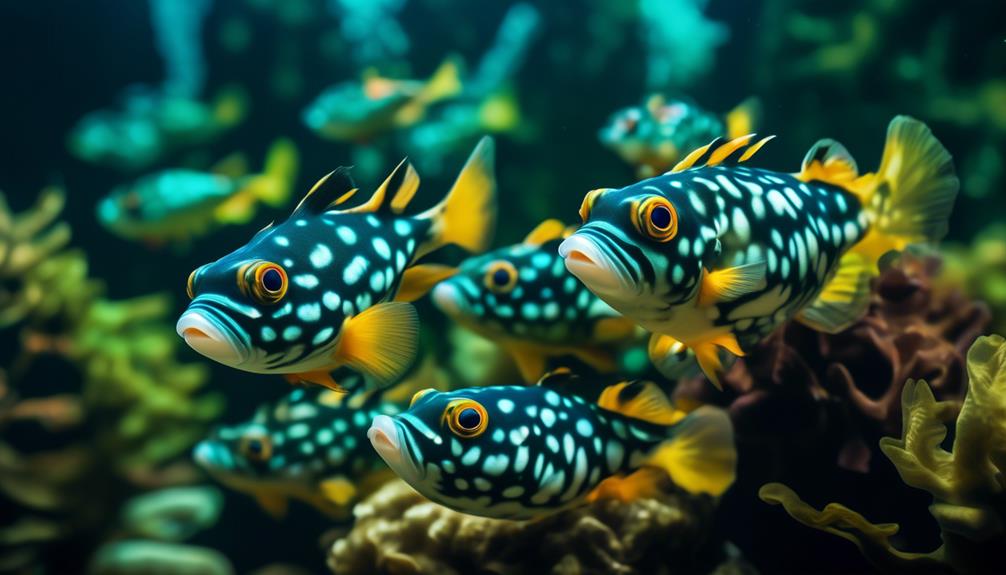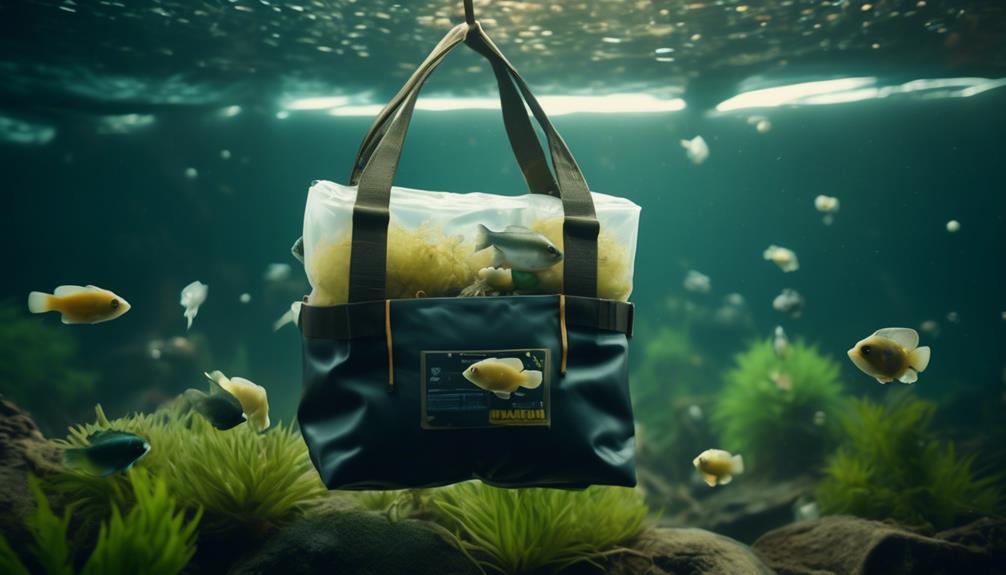Welcome to the captivating world of the Amazon Puffer, a remarkable fish species that embodies both elegance and resilience. Native to the lush landscapes of the Amazon basin and its surrounding regions, the Amazon Puffer, also known as Colomesus asellus or South American puffer (SAP), possesses a stunning golden yellow body adorned with dark bands, complemented by a pristine white underbelly.
Its adventurous nature leads it to explore a diverse range of habitats, from tranquil floodplain lakes to swiftly flowing rivers. In this article, we will uncover the secrets behind acquiring and acclimating these wild-caught beauties, as well as the challenges faced by fish farms in breeding them in captivity.
We will also shed light on the importance of deworming techniques to combat internal parasites that these puffers are susceptible to, and provide insights into their behavior, lifespan, and the essential precautions when setting up an aquarium to ensure their optimal well-being.
Ready to dive into the world of the Amazon Puffer? Let's embark on this fascinating journey together.
Key Takeaways
- The Amazon Puffer, also known as Colomesus asellus or South American puffer, is found in the Amazon basin and surrounding areas.
- When buying Amazon Puffers, it is important to be cautious as they are usually caught from the wild and may have health issues.
- Deworming treatments are necessary for Amazon Puffers as they are prone to internal parasites like tapeworms.
- Amazon Puffers can live up to 8-10 years or even longer and require a suitable tank setup with enough space and hiding spots.
Buying and Quarantining Amazon Puffers
When it comes to acquiring Amazon Puffer fish, it is crucial to exercise caution and ensure proper quarantine measures are taken. These puffers are typically caught from the wild as breeding in captivity has not been successful. As a result, they may be skinny and have parasitic infections. To avoid purchasing an unhealthy puffer, it is important to inspect their physical condition, avoiding those with a concave abdomen or white spots.
Quarantining the puffers in a separate tank is essential to prevent the potential spread of diseases. The best places to purchase healthy Amazon Puffers are reputable fish stores known for their quality and expertise. By following these precautions, you can ensure the well-being of your Amazon Puffer and prevent any potential diseases from affecting other fish in your tank.
Deworming Amazon Puffers
To ensure the health and well-being of Amazon Puffer fish, it is imperative to address the issue of deworming. These pufferfish are prone to internal parasites, such as tapeworms, which can lead to serious health problems if left untreated.
To prevent parasitic infections and maintain the overall health of Amazon Puffers, the following deworming techniques are recommended:
- Dewormers: Administer deworming medications specifically designed for fish, as they are effective in eliminating adult worms. However, it is important to note that these medications do not eliminate unhatched eggs.
- Multiple Treatments: Since dewormers only target adult worms, multiple treatments are necessary to eliminate all the eggs that may hatch later. Follow the specific instructions provided with the medication and wait the recommended time between treatments.
- Recommended Products: Use quarantine medication trio, Fritz ParaCleanse, and PraziPro, as they have been found to be effective in deworming Amazon Puffers.
Behavior and Lifespan of Amazon Puffers

The behavior and lifespan of Amazon Puffers exhibit intriguing characteristics and can provide valuable insights into their natural history and care requirements.
One notable behavior of Amazon Puffers is their ability to puff up by sucking in water or air as a defense mechanism. However, it is important not to deliberately stress them to see this behavior as it can be harmful to their health.
As for their lifespan, Amazon Puffers can live up to 8-10 years or even longer with proper care. Factors that can affect their lifespan include water quality, diet, stress levels, and the presence of diseases or parasites.
It is crucial to provide them with a suitable environment and meet their specific needs to ensure a long and healthy life.
Setting Up an Aquarium for Amazon Puffers
Continuing our exploration of Amazon Puffers, we now turn our attention to the crucial task of setting up an aquarium that meets their specific requirements.
To create an optimal environment for Amazon Puffers, consider the following:
- Tank Size: It is recommended to have a tank size of at least 30 gallons, preferably 55 gallons. This provides ample swimming space and allows for a small group of six or more puffers to be kept together to avoid territorial disputes.
- Water Parameters: Amazon Puffers are hardy and adaptable to a wide range of water conditions. They can thrive in pH levels of 6.0-8.0, both soft and hard water, and a temperature range of 72-82°F (22-28°C). Regular monitoring and maintenance are essential to maintaining water quality.
- Tankmates: When choosing tankmates for Amazon Puffers, it is crucial to consider their compatibility. Avoid aggressive or fin-nipping species. Suitable tankmates include peaceful community fish like tetras, corydoras catfish, and small peaceful cichlids.
Tips for Transporting Amazon Puffers

When transporting Amazon Puffers, it is important to ensure their safety and well-being throughout the journey.
To achieve this, proper transportation methods should be employed. One effective method is to use a small plastic tub or catch cup to transport the puffers, as this reduces the risk of them sucking in air, which can be harmful to their health. It is crucial to avoid netting the puffers, as this can cause stress and lead to the ingestion of air.
Additionally, acclimating the puffers to a new tank is essential for their successful transition. This can be done by gradually adding small amounts of water from the transport container to the new tank over a period of time.
Frequently Asked Questions
Are Amazon Puffers Compatible With Other Fish in a Community Tank?
Tank mates for Amazon puffers should be chosen carefully due to their territorial nature and potential aggression. Compatible species include large tetras, peaceful catfish, and some cichlids. Provide ample hiding spaces and create a balanced ecosystem to ensure the perfect environment for Amazon puffers.
How Often Should I Feed My Amazon Puffer and What Type of Food Is Best?
The ideal feeding frequency for Amazon puffers is 2-3 times a day, offering a varied diet of live or frozen foods such as bloodworms, brine shrimp, and small crustaceans. This ensures their nutritional needs are met and promotes optimal health.
Can Amazon Puffers Be Kept in a Brackish Water Tank?
Amazon puffers are typically found in freshwater habitats, such as floodplain lakes and rivers. They are not naturally adapted to brackish water conditions. Therefore, it is recommended to keep them in a freshwater tank.
Do Amazon Puffers Require a Heater in Their Tank?
Using a heater in an Amazon puffer tank has pros and cons. While it helps maintain a stable water temperature, it can also lead to overheating. Tips for maintaining water temperature include using a reliable heater and regularly monitoring the tank temperature.
Can Amazon Puffers Be Trained to Recognize Their Owner and Hand Feed Them?
Training techniques for amazon puffers can include positive reinforcement, repetition, and consistency. While they may not recognize their owner or be hand-fed, social interaction is important for their well-being and can help build trust and reduce stress.
Conclusion
In conclusion, the Amazon Puffer is a captivating fish species with its stunning golden yellow body and unique characteristics.
Buying and quarantining these puffers can be challenging, but it is important to ensure their well-being.
Deworming techniques are crucial in combating internal parasites that these fish are susceptible to.
Understanding their behavior and lifespan is essential for their optimal care.
When setting up an aquarium, it is necessary to take precautions to provide a suitable environment for these hardy creatures.
With proper care and attention, the Amazon Puffer can thrive in captivity.

